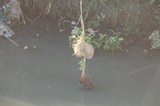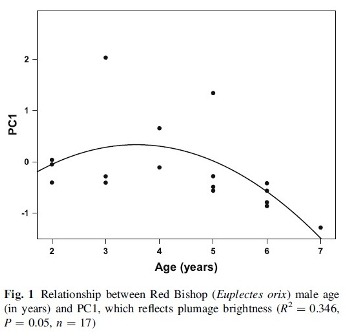Weaver news
|
Abstract. Males in many bird species develop elaborate carotenoid-based plumage ornaments which often play an important role as signals of individual quality in intra- or intersexual selection. However, knowledge of the pattern of age-related variation in plumage traits is crucial to interpret results on associations between plumage signals and reproductive performance. We investigated how age is related to brightness and carotenoid saturation of the orange-red breeding plumage in males of known age in the Red Bishop (Euplectes orix), a polygynous and sexually dimorphic weaverbird species. We found that the relationships of both plumage brightness and carotenoid saturation with age were best explained by a quadratic function, with males in their prime (i.e. 3–5 years old) having a brighter and more carotenoid-saturated plumage than both very young and very old males. The implications of our results for studies in the context of animal signalling are discussed. The investigation of the relationships between age and two principal components gave a quadratic relationship between age and both PC1 (plumage brightness; Fig. 1 right) and PC2 (carotenoid saturation) - very young and very old males showed less bright and less carotenoid-saturated plumage compared to males in their prime. The authors think that a brighter plumage here is equivalent to having less melanin in the plumage and thus appearing less dull overall. Read previous reviews about this study population of Southern Red Bishops at Addo Elephant National Park, Eastern Cape Province, here. Literature as featured in Weaver Watch news items |











 Edler AU, Friedl TWP. 2012. Age-related variation in carotenoid-based plumage ornaments of male Red Bishops Euplectes orix.
Edler AU, Friedl TWP. 2012. Age-related variation in carotenoid-based plumage ornaments of male Red Bishops Euplectes orix.